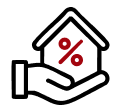Mortgage Refinance Solutions
Refinancing your mortgage can be a smart way to optimize your finances, whether you want to lower payments, access cash, or adjust your loan terms. It gives you the opportunity to tap into your home’s equity or secure a better interest rate, helping you save money or meet other goals. With various refinancing options available, it’s important to understand which one is best suited to your needs.
 Outstanding Client Experience
Outstanding Client Experience Specialized Lending Solutions
Specialized Lending Solutions Direct-to-Consumer Advantage
Direct-to-Consumer Advantage We're Advisors, NOT Salespeople
We're Advisors, NOT Salespeople Effortless Digital Mortgage Platform
Effortless Digital Mortgage PlatformTable of Contents
Featured In:
![]()
![]()
KEY TAKEAWAYS
- Refinancing your mortgage can help you lower your interest rate, reduce monthly payments, access home equity, or adjust your loan terms.
- Streamlined refinancing options, like those for VA, FHA, and USDA loans, simplify the process by reducing paperwork and offering faster approval.
- Cash-out refinancing allows you to tap into your home’s equity, providing funds for home improvements, debt consolidation, or other expenses.
- Home equity loans or lines of credit can be an alternative to refinancing your first mortgage.
- Reverse mortgages can allow homeowners 62 or older to convert their equity into cash, while rate-and-term refinancing is a popular choice to secure a better interest rate without cashing out home equity.
Why Refinance Your Mortgage?
Here are a few reasons why you might consider mortgage refinancing:
- Lower your interest rate: Refinancing can allow you to lock in a lower mortgage rate, reducing your monthly payment and the amount you pay in interest over the life of the loan.
- Extend or shorten loan term: Shorten your loan term to pay off your mortgage faster or extend it for smaller monthly payments.
- Access home equity: Refinance a home equity loan to fund major expenses like home improvements, college tuition, and much more.
- Change loan types: Move from an adjustable-rate mortgage (ARM) to a fixed-rate mortgage for more stability.
- Consolidate debt: Home refinancing loans can allow you to consolidate different high-interest rate debts into a single payment at a lower rate.
Ultimately, refinancing your mortgage can be a smart financial move for many reasons. When you refinance, you’re essentially replacing your current mortgage with a new one that allows you to capitalize on changes in market conditions or improvements in your own financial profile.
Deciding between a second mortgage vs refinance option might be part of your decision as well, depending on your specific needs. You may also want to refinance a non-QM loan if you don’t qualify for conventional financing.
Think you qualify for a loan? Contact us today to find out!
Contact UsHow Does Mortgage Refinancing Work?
A mortgage loan refinance allows you to replace your existing loan with a new one, often to secure a lower rate, change the loan term, or tap into your home’s equity.
Here’s a general overview of how mortgage refinancing works:
- Evaluate your goals: Decide why you want to refinance your mortgage. Is it to lower payments, access equity, switch loan types, or something else?
- Shop for lenders: Compare offers to find the best mortgage refinance loan rates and terms.
- Submit your application: Complete an application, providing documents like income statements and credit history.
- Lock in your interest rate: Once approved, lock in the interest rate with your lender.
- Underwriting: The lender reviews your application, verifying all of your financial details.
- Home appraisal: In most cases, an appraisal is conducted to confirm your home’s current market value.
- Close on the loan: Sign the final documents and enjoy your new loan.
Keep in mind that how long it takes to refinance and the exact process can vary based on the type of refinance mortgage loan you choose. Certain programs and lenders can also impose restrictions, such as required waiting periods or equity thresholds. Learning more about mortgage refinance limits can help you set realistic expectations and time your refinance strategically.
Think you qualify for a loan? Contact us today to find out!
See if you QualifyMortgage Refinancing Options
Mortgage refinancing offers several options to help you manage your loan. Whether you want to lower your interest rate, access cash, or adjust your loan terms, there are various home mortgage refinance loans to explore.
Rate-and-Term Refinancing
Rate-and-term refinancing simply allows you to adjust your mortgage’s interest rate or loan term, making it ideal if you want to lower monthly payments or pay off your loan sooner. For example, you can:
- Refinance an adjustable-rate mortgage to a fixed-rate loan and lock in predictable payments
- Refinance an investment property to improve cash flow
- Drop your private mortgage insurance (PMI) once you reach a sufficient level of equity
Rate-and-term refinancing is a popular option when interest rates drop or if you’re in a better financial position than when you first took out your loan.
Cash-Out Refinancing
Cash-out refinancing allows you to access your home’s equity by replacing your current mortgage with a larger loan and taking the difference in cash. This can be helpful if you need funds for major expenses like:
- Completing home renovations
- Consolidating debt
- Paying for medical expenses
- Covering business expenses
- Freeing up cash for other investments
We also offer a self-employed refinance loan, which allows you to qualify using bank statements rather than traditional income verification. Additionally, we offer a VA cash-out refinance option for veterans, which provides more flexibility at a low rate.
If you’re unsure how much equity you can qualify for, use the cash-out refinance calculator to help. Ultimately, cash-out refinancing is ideal if you need immediate capital and are comfortable with taking on a larger loan.
Streamline Refinance Loans
Streamline refinance loans simplify the refinancing process, making it faster and easier to reduce your interest rate or monthly payments. Lenders often skip traditional steps like income verification or appraisals with streamline refinancing. It’s an ideal option if you have a government-backed loan and want to improve your loan terms without the hassle of a full refinance.
Examples of streamline refinance loans include:
- VA Loans: A VA loan offers a VA streamline refinance, also known as the VA IRRRL, to lower rates quickly and the VA cash-out refinance option for accessing equity.
- FHA Loans: An FHA loan also provides streamline refinancing to help borrowers reduce payments.
- USDA Loans: A USDA loan allows a streamlined refinance process for rural homeowners.
Reverse Mortgage
A reverse mortgage allows homeowners aged 62 or older to tap into their home’s equity without making monthly payments. Instead of paying the bank, the bank pays you, either as a lump sum, monthly payments, or a line of credit. This option is often used by retirees who want to supplement their income, cover healthcare costs, or pay off existing debts.
Unlike other types of refinance mortgage loans, a reverse mortgage loan grows over time and is typically repaid when the homeowner sells the home, moves, or dies. For those interested, it’s possible to refinance a reverse mortgage to secure better terms or adjust payout options.
Begin the application online or request a free quote today!
Get StartedSee If Refinancing Your Mortgage Can Help You Save
When you’re ready to take the next step in refinancing your mortgage, Griffin Funding is here to help. With a variety of loan options, including competitive refinance rates and flexible terms, Griffin Funding can help make your mortgage refinancing process simple and seamless.
Plus, with the Griffin Gold app, you can manage your finances on the go, access loan details, and get real-time updates, all at your fingertips. Take control of your financial future and start your journey with Griffin Funding today!
Frequently Asked Questions
Yes. Griffin Funding specializes in a wide range of mortgage loan refinance programs, including conventional, VA, FHA, USDA, and non-QM options. Whether you’re looking to lower your rate, adjust your loan term, or access cash from your equity, our team can guide you through the best solution tailored to your financial goals.
Refinancing is often a good idea if you want to reduce your interest rate, lower monthly payments, access equity, or switch loan types for greater stability. It can also make sense when market conditions improve or your credit profile strengthens. Learn more about when to refinance to see if now is the right time.
The cost to refinance varies depending on your loan size, lender fees, and closing costs. On average, you can expect fees to range between 2% and 6% of the loan amount. Griffin Funding works to provide transparent costs upfront so you know exactly what to expect before closing.
The refinance process typically takes between 30 to 45 days, depending on your lender, the complexity of your application, and whether an appraisal is needed. Streamline refinance loans can be completed faster since they involve less paperwork and fewer requirements.
Yes. Many options are available for refinancing investment properties, including rate-and-term and cash-out refinance loans. Investors may especially benefit from a DSCR cash-out refinance, which allows you to qualify based on property income rather than personal income, making it easier to expand your real estate portfolio.










